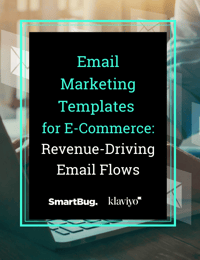
When most brands think of an email campaign, the first things that come to mind are newsletters and sales promotions.
Although these are important items in a brand’s marketing efforts, sticking to these two types of emails is going to exhaust the audience and dissolve your contact list. Plus, if you think about it, every other company is sending sales promotions and newsletters. There needs to be a relationship between the brand and the audience, not just an exchange.
Email and SMS campaigns are two of the best ways to build customer loyalty. Customers don’t just want deals—they want to have an entertaining, educational, personalized experience. In other words, they want to build a deeper relationship, and you can do this by engaging with them through direct, immediate channels.
There’s a lot more variety to email campaigns than most brands might think. In this article, we provide an overview of types of email campaigns as well as a set of Klaviyo best practices to help you launch your first email campaign.
Creating a Campaign in Klaviyo
Before we jump into the types of email campaigns you should be sending, let’s go over a few best practices in Klaviyo, a marketing automation platform that automates SMS and email marketing.
Your email campaign—which can be a newsletter, sales announcement, or promotional material—will be sent to a target audience. A campaign can either be sent immediately or prepared in advance to be sent at a later date.
1. Conduct Preliminary Work
Before your can write and send an email, you’ll need to do two things:
- Create a contact list. Will this email be sent to your entire contact list? Or will it be sent to a segmented list for better results?
- Create base templates. These can be leveraged for future campaigns, saving you and your writers and designers a lot of time.
From there you can create your email campaign in Klaviyo. Once you get started you’ll be asked to select your recipients, create content, and review and send.
2. Choose the Recipients
On the first screen of Klaviyo’s campaign wizard guide, you’ll be asked to select the basic settings of your campaign, such as the name of the campaign, who will receive the email, and how the email will be sent.
The list of recipients that will receive this email is important. It should be targeted to the segments of your audience that are most likely to benefit from the campaign. Segmenting can be based on any number of factors, such as contacts who have purchased similar items, demographics, and more.
Remember, the customer needs a personalized journey, so receiving information that isn’t relevant to them can potentially damage their relationship with the brand. If you don’t have a list of contacts yet, consider building a strategy to grow your contact list.
3. Create the Email Content
Next, you will select your template by either creating a new one or selecting one from your template library. Be sure to check the subject line, sender name and email address, and the reply-to email address if you want responses to go to a specific email address.
Klaviyo has three options for creating content:
- Drag-and-drop function optimizes your content for mobile devices and complex email layouts.
- Text only is for text-only emails that look like they came from a personal email address and not a company email address.
- HTML templates can be imported or coded from scratch.
From there, use the drag-and-drop editor to make changes to your design and save content. In the next main section, you’ll learn more about campaign ideas and tips for creating content.
4. Schedule and Send Your Campaign
The last step is to review, schedule, and send your campaign. During this step, you can choose to perform A/B testing to discover which variation of the email campaign performs best. Finally, select whether you want the campaign sent immediately or at a later date.
In the next main section, you’ll find ideas for A/B testing in your own campaigns.
Ready to learn how our e-comm marketers can help you? Get in touch!
Five Types of Emails You Should Be Sending
So, now that you know how to create an email campaign in Klaviyo, what types of content should you be sending?
Email marketing is as much about creating a strong brand-customer relationship as it is about promoting a product or service. To that end, here are five types of emails you should be sending:
1. Product Promotion
Although plenty of companies create and release new products, not enough effort is put into the marketing efforts to promote the product. Not only will this help drive sales, it also gathers data to learn who is interacting and converting on the products, giving you more information about how to segment your audience.
Product promotion begins with pre-sale promotion. Pre-sale has a number of benefits, including:
- Creating a sense of exclusivity for your contacts by making them the first to know about a new product.
- Testing the product by sending the contact list the initial product before it launches, gaining insight into the success or failure of the product before sending it to mass production.
After the pre-sale or pre-signup, the product launch date involves sending an email to the active engaged list. A day or two later, resend to those that did not open the first email and exclude those on iOS with tracking turned off.
Companies should aim for at least one new product every six months, but many companies will launch entire collections every month, depending on the size of their customer base and engagement.
2. Lifestyle Campaign
With a lifestyle campaign, the main goal is not to sell but rather to build excitement and drive education, interest, and entertainment. Interestingly, lifestyle campaigns that are consistent tend to drive sales by inspiring their followers.
Typically, the email sequences for this campaign are in a blog-style format but much shorter. Essentially, you’re working on building trust in the brand-customer relationship.
This email campaign can link to a landing page, blog post, or even suggest related products. Although it’s okay to include related products, they shouldn’t be the focal point. Instead, include links to the products at the bottom of the page.
3. Content Promotion
You can also use your email campaign to promote content, such as blog posts or e-books, and your social media pages. Here, you’re using your email list to drive traffic to other pages to boost your domain authority on Google and diversify the ways in which your audience interacts with your brand.
Alternatively, if the secondary goal is to keep engagement in email and drive clicks to a product, content can be completely contained within email and not linked to a blog post or social page.
4. Personalized Campaign
A personalized campaign is a text-based campaign, which means that your email should feel like it’s coming from an individual rather than the company. Many brands will send an email from a president or CEO that is written in first person.
A few best practices when writing emails for a personalized campaign include:
- Making the email text-based. Brands often make the mistake of thinking that highly polished, fully designed emails will do better. Design should be minimal to give the email a more personal touch.
- Writing short, simple, engaging content that doesn't take a lot of mental load on the user. Heavy emails are often deleted or left unread because people are inundated with content across the web.
There’s a range of content that could be included in a personalized campaign. For instance, the email could be sent out at the beginning of the year announcing new products for members of the email list. The email could also include a video.
Whatever the content, the email needs to make the audience feel like they’re actually in conversation with the brand.
5. Events Promotion
Email and SMS are channels that your audience is most likely to see, which makes it a great way to provide educational, entertaining content that promotes the event and increases numbers at the in-person event or live event on a social media page.
Get Klaviyo Best Practices from a Team of E-Commerce Marketing Experts
Email and SMS marketing services can be used to drive revenue, develop a relationship with your customers, and promote a variety of content and products. Our team of e-commerce strategists, writers, and designers will deploy a proven strategy to take the guesswork out of your email and SMS marketing by building a monthly campaign calendar and providing ROI on your investment.
Ready to chat with one of our e-comm marketers? Get in touch today!

About the author
Ryan O’Connor was formerly SmartBug’s Director of E-commerce Growth, product manager, and sales director. He enjoys helping readers learn how to solve big business challenges through consumer psychology within the constantly evolving e-commerce landscape. Over the past 10 years, Ryan has helped 1000s of DTC brands navigate challenges to grow fast through intelligent marketing. He’s not afraid to get his hands dirty, having launched his own e-commerce stores from the ground up. Read more articles by Ryan O’Connor.









